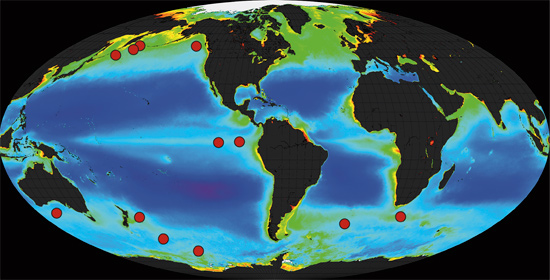"Did the ocean iron fertilization in Haida Gwaii islands a couple of weeks ago, cause the earthquake yesterday? Just a thought." - From a BBC concerned citizen
~~~~~~~~~~~~~~~~~~~~~~~
UPDATE: September 4, 2013 Oceanus Magazine:
Will Ocean Iron Fertilization Work?
Getting carbon into the ocean is one thing. Keeping it there is another.
AND
~~~~~~~~~~~~~~~~~~~
As tectonic plates go, the Pacific one is slowly slipping beneath the North America plate.
What holds them together are the "padlocks" of lithosphere, which has a higher strength and lower density than the underlying asthenosphere.
 Iron fertilization, with Nelson Skalbania's involvement, has "rusted" those "padlocks".
Iron fertilization, with Nelson Skalbania's involvement, has "rusted" those "padlocks".How Iron fertilization is suppose to work:
Wikipedia: "Iron is a trace element necessary for photosynthesis in all plants."
If you've forgotten about photosynthesis:
"....Photosynthesis is a process used by plants and other organisms to convert the light energy captured from the sun into chemical energy that can be used to fuel the organism's activities. ..."
In 2007, Planktos Corp. tossed 45 tons of iron filings overboard near the Galapagos Islands:
Planktos Corp. has made headlines in newspapers around the globe, including the New York Times and the Daily Telegraph, on account of its plan to toss 45 tons of iron filings into the South Pacific Ocean near the Galapagos Islands. The theory is that this will stimulate plankton growth, which will promote the absorption of carbon dioxide and impede global warming.
The idea, the Times noted, is similar to planting forests full of carbon-inhaling trees, which is what Planktos is also doing in Hungary.
So how will Planktos make money from these ventures?
In both projects, environmentally conscious corporations and individuals will have the opportunity to offset the carbon dioxide they emit by paying Planktos a few dollars for every ton of carbon dioxide their projects absorb from the atmosphere. - The Vancouver Sun June 23, 2007
You may be about to laugh at our logic here at the BBC, but to hear a proponent say that the process of photosynthesis turned the tide to favour "Galvania" theorists near the Galapagos Island, therefore it will work off of Haida Gwaii as well, ..... isn't quite true when it comes to the god called "Sunlight".
Galapagos Islands Temperatures range from 69°-84°F / 21°-30°C
People living on the Equator, experience only Two Seasons.
Haida Gwaii Temperature range 32°-64.4°F / 0°-18°C
Haida Gwaii has .... Four Seasons
***********************
*************
*************
Key Points to Understand
• Slanted light does not heat objects as quickly as direct light.
• Because the Earth is nearly round, the equator receives direct light, and the poles receive slanted light, with a gradation in between.
• Due to the differential heating of the Earth’s surface (unequal heating of all regions), it is always warmer at the equator than at the poles.
Background Information
Temperatures at the equator are, on average, the hottest on the planet. It is a common misunderstanding that it is hotter at the equator because the equator is closer to the sun. Its location at the center of the Earth is what makes its average temperature warmer than any other place on Earth, because the equator always receives direct sunlight, whether it is summer or winter. Because of the Earth’s spherical shape, sunlight hits the equator directly year-round, unlike the North and South Poles. ........
Source: Grade 6 to 8
~~~~~~~~~~~~~~~~~~~~~
Daylight to Night, Summer to Fall and back to Summer,at the Equator (Galapagos), is an almost even split of 12 hours on, 12 hours off
Daylight to Night, at Haida Gwaii, in the Winter .... :
Being as far north as we are (above 54 deg N), the Winter daylight is very short with the Sun (if we see it at all) after 8:30AM local, and Setting shortly after 3:00 PM. The sun doesn't Rise more than about 20 degrees above the horizon. Six and half Hours!
..... the middle of summer, the Sun rises before 5:00am with Sunset not until after 10:00pm. Seventeen Hours! DX-er.ca DX is ham radio shorthand for "distance"
There are some similarities between Haida Gwaii and the Galapagos:
The diverse geography and landscape of the Islands is reflected in its biological diversity. There are a large number of plant and animal species and sub-species that are only found on the archipelago. This is one reason why the Islands are often referred to as “the Galapagos of the North.”



1 comment:
I do remember trying to start a slip from a house plant for my friend. Waiting for quite some time, I realized the slip needed some leaves for photosynthesis.
Some also mentioned fracking causing earthquakes too.
What are the chances, this earthquake will through to, Enbridge, Premier Redford and Harper's head? It is not a good idea, to string a pipeline across BC, nor bring massive tar tankers into those seas?
Post a Comment